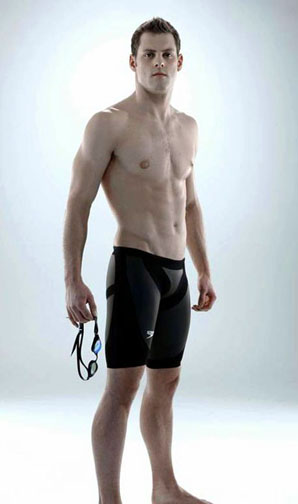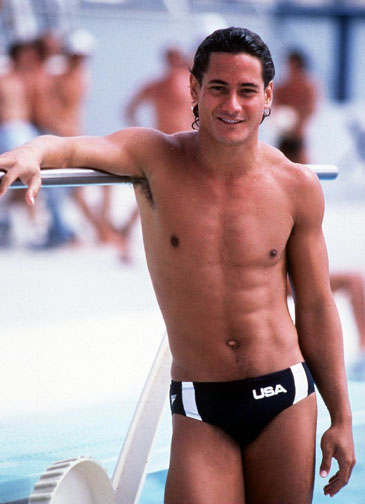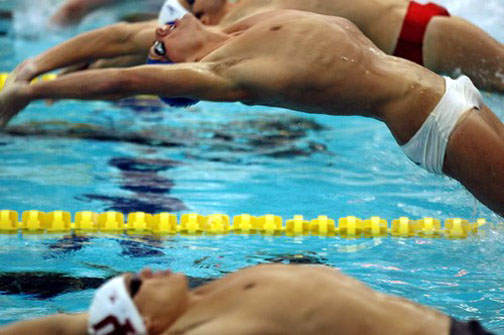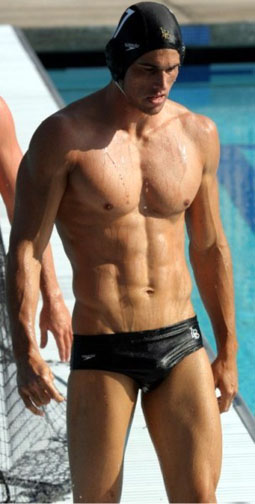Tags
Moms, for some unfathomable reason seeing as how neither of my parents ever learned to swim, decided to enroll my brothers and I – at the age of three – in the Red Cross’ swimming classes at the local high school during the summer months. At that age it’s not so much about learning to swim as it is about learning how not to drown. That’s not a bad skill to master at any age. Quickly passing through the various levels of water safety over the next two summers, by the age of five all three of us began swimming competitively. My older brother and I both continued through college.
When you join a swim team at the age of five, you start off in the ‘six and under’ class, competing with others like you who are still mastering the art of walking without falling down. At that age the competition is more about reaching the other end of the pool than it is about racing, though someone manages to hit the wall before the others and gets rewarded with both a nasty looking bump on the head and a ribbon. As you get older you move up in age class, learn how to hit the wall with your hand instead of your head, and through either persistence or talent learn to specialize in and perfect a stroke.
I was drawn to the backstroke. One of my early coaches was a backstroker and watching her glide across the pool spouting a mouthful of water into the air that would make Moby Dick jealous sealed my fate. That it is one of the few sports events in the world that you can engage in while lying on your back didn’t hurt either. It’s not the fastest stroke, in fact it is the opposite. But backstrokers master the flip turn, a fairly impressive feat if done correctly since you hit the turn blind, which is always a crowd pleaser. And if you are any good, the backstroke is the initial leg in the medley relay – you can put your team far out in front of the other competitors from the start, which always makes you popular with your teammates.
Spending your youth in California hanging out at the pool during the summer is not a bad way to grow up. Spending your youth as a gay man in the making surrounded by buddies who all are wearing what amounts to nothing more than a skimpy pair of underwear ain’t bad either. By the time you enter High School and have glommed onto the fact that there is something besides peeing that your dick is good for, spending a good part of your year hanging out with a bunch of almost naked guys, most of whom have bodies to die for, for a gay boy, can’t be beat. And entering High School as a nationally ranked swimmer negates the trials and tribulations all of your classmates suffer through as freshmen from your life.
While your classmates attempt to find standing in the community, most failing miserably and becoming social pariahs for life, you are automatically accepted into the world of jocks. Lettering as a freshman puts you in the top ranks at school; you’re popular, teachers all cut you slack, and you learn to swagger at an early age. Lettering as a swimmer means you get respect from the other jocks while everyone else at school knows you aren’t really a jock. Most swimmers adapt equally well with the world of stoners, and you end up being part of two cliques while a good number of your fellow students never manage to fit into even one. And then there is all the male nudity.
Going from suited to naked for a swimmer is a matter of a single garment. One that hides little in the first place. As a swimmer it is important to hop into the shower as soon as you’ve hopped out of the chlorinated water of the pool (I don’t know why that is important, but it’s one of those benefits you just don’t argue with). Swimmers are naked by the time they’ve fully entered the dressing room. And most stay that way until their next event. I’m sure if more gay boys knew this, even more would join a swim team at an early age. I’m not sure why young gay boys have been drawn to diving as much as they seem to have been, but since the diving team is part of the swim team, they too get to take part in the naked camaraderie of competitive swimming. Though being divers, they are always a bit suspect.
In High School, diving was an afterthought, an event turned to by those who wanted to be on the swim team but who swam like a rock. Most of the other schools we swam against didn’t even have a diving team and when they did judging was a capricious and arbitrary process that relied more on school lines than it did on skill levels. One of our two divers, Tracey, was a tall thin blonde who I’m sure became a tweaker after he graduated. He was always stoned during meets and had developed the build of a meth addict by the age of 16.
At 5’ 10” he weighed in at 100 lbs. on a good day, and the only time any of us bothered to watch the diving competition was on especially windy days. Being an obvious masochist, Tracey liked inverted dives the best. Just as he got himself balanced, hanging at the edge of the 1 meter board clinging to his mount with nothing but the power of his toes, a gust of wind would come along and blow him off the board. Tracey is the only diver I’ve ever known whose degree of difficulty fluctuated with wind direction. Our team’s judges awarded points for how far off the board a breeze had carried him. Yup, swimmers are not generally known for their compassion.
But they are known for their skimpy swimsuits. Speedo has that market wrapped up worldwide and has had ever since I started swimming. From my initial floundering that passed as a stroke at the age of five through my college years, Speedos were made of nylon. The only change from one year to the next was the color of the suit, which was dictated by the team you were on. Around the time of Junior High School, you learned to wear your suit about an inch lower on your waist than the manufacturer intended. That had nothing to do with cutting friction to improve speed. It was all about style.
With the crack of your ass almost exposed at the back, the suit fit your butt like a glove. Up front, regardless of the size of your bulge, the extra inch in material formed a pocket to nestle your junk. An impressive bulge was the way to go, outlining your cock for the world to see was not. And as soon as you hopped out of the pool, win or lose, you pulled your suit away from your body in a quick tug that allowed air to smooth out your bulge and re-undefine your best buddy. What you were packing was not for spectators’ enjoyment. That was a thrill reserved for your teammates back in the dressing room.
College was no different; instant acceptance in any group or clique you cared to join except for motley groups of future IT nerds. Some swimmers joined fraternities, most just opted to attend their parties. That photo of Michael Phelps hitting a bong should not have surprised anyone; swim practice with a hangover is no more excruciating than the pain involved in getting out of bed or off the floor.
Swimming in college took on a slightly more serious tone; some actually believed they had a future in the sport. Even though Mark Spitz had set new world records sporting a pornstache, serious competitors shaved their bodies to lessen friction in the water. Real serious competitors even shaved those parts of their body that were not exposed to water. And the rest of us ridiculed them back in the dressing room. The fraction of a second shaving resulted in meant little if you still failed to qualify for the final heat. But then the real heat was among the swimmers living away from home for the first time in their lives who felt free to explore new worlds. Records set in college for me were not so much about swimming but scoring teammate booty.
Unless you were born with gills and won a berth on the Olympic team, your competitive days as a swimmer come to an end when you don your cap and gown at the university. There are no professional swim teams to join and be paid millions of dollars for engaging in the sport you’ve enjoyed most of your life. I spent a few years during the summer months performing for a water skiing show, which paid diddly, swam for the enjoyment of it, and lounged around pools in my speedos to catch the eye of available hotties. Competitive swimming became a thing of the past. And, a few years later while watching swimming at the Olympics I learned how quickly one can become an anachronism.
In my day, part of the coolness of being a backstroker was the start of the race. Huddled into a tight ball perched on the side of the pool, the gun would go off and you’d burst into the air like a breeching whale. A quick, shallow dip on landing, perfected to be kept at a minimum, and you were off. Now backstrokers finish almost the first lap of the race under water performing a dolphin kick and moving not unlike that mammal glides beneath the surface of the ocean. That would have been an automatic disqualification when I swam. I haven’t a clue as to when, or why, they changed the rules. Not all progress is a good thing, regardless of the speed it allows for. But then Speedo made some changes, quit resting on their laurels and started manufacturing new suits too. And in my book, that was a good thing.
Lycra is one of the greatest achievements of mankind. The traditional Speedo swimsuit stayed the same in shape, but its new material did away with the demure pocket the old suits allowed to stash your junk in. There was no longer any guess work in determining just how well a swimmer was built. Even if you did not have the advantage of a viewing spot back in the team dressing room. Size, shape, cut or uncut . . . it’s all now on display. I can’t tell you the exact date Speedo made the change but have a strong suspicion it was due to some designer taking one look at Greg Louganis’ incredible body and thinking how much better he’d look naked. And that man deserves the Nobel Peace Prize at the very least.
Unfortunately, Olympic television coverage, concerned with the sensibilities of the prudish, ensures close-up shots of swimmers and divers are from the waist up. I think diving has become as popular as it has for no better reason than they can’t avoid televising full body shots during the diving competition. And I don’t care how straight a viewer thinks he is, he’s still a guy and still checks out any other guy’s bulge. Some of those Olympians have some pretty impressive bulges. Ian Thorpe isn’t known as the Thorpedo because of his speed in the water. When I graduated from college I shoulda gone the coaching route. I might not have the money I do, but damn if that eye candy wouldn’t have been worth it.
Along with the bulge, the Speedo brand was branded and became known to those outside of competitive swimming. Guys who could barely float started showing up a pools all over the world in bulge defying swimsuits and Speedo became a style of suit on top of being a brand. Unfortunately, guys way past their prime started turning up beachside wearing speedo knockoffs too. Speedo needs to start suing for damages, singling out the elderly and obese for wearing their suits. And they can start in Pattaya. But possibly thinking that would not be a good public relations move the company has gone with a different mode in protecting its brand and instead has switched over to the body suit. Fatties may be able to cram their bloated balls into a skimpy pair of Speedos, but they’ll never get the rest of the suit up over their stomachs. And on the well-built, on the studs their suits were designed for, their newer line highlights the bulges that the gods intended.
The LZR Racer is Speedo’s new design. When they first came out I was a bit disappointed. The whole purpose of watching swimming was all the skin on display. And they’ve covered all that skin up. The new ‘spray on’ suits leave little to the imagination, but then they are so form fitting that what they do show is often a shadow of its real self. And where swimmers once only had to decide if they would dress to the right or left, with the new suits its more of a ten o’clock, noon, or two o’clock positioning choice. I don’t know if the new style of competitive suit was a good move for the swimming world. Men of less stature surly shy away from the sport now. Having the world know you are built like a fish can not be a good thing.

Itallian Olympian Filippo Magnini shows what the bulge is all about over Arena’s Elite Team full body swimsuit.
Body defining technology aside, the new high-tech suits made from polyurethane made their Olympic debut at the Beijing Olympics and have been controversial ever since. At those Games, twenty-three world records were broken by swimmers who wore LZR Racer suits, compared with only two that were broken by swimmers who didn’t. Speedo claims 89 percent of all the medals in swimming, including 94 percent of the gold medals, were won by LZR Racer wearing swimmers.
The new full body suits incorporate polyurethane panels over the parts of a swimmer’s body that produce the highest drag. The material also acts as a full-body girdle; it squeezes and slims down swimmers “so the skin doesn’t wobble around as they go through the water,” allowing the athlete to slide through water faster. This has caused many within the sport to complain that it is the suit, and not the swimmer, who is winning races. The controversy came to a head at the 2009 World Championships when German swimmer Paul Biedermann broke two world records while wearing a suit of similar construction manufactured by Arena. Biedermann’s breaking of both Ian Thorpe’s 400m world record as well as Phelps’s 200m record have been largely attributed to the superiority in the design of his swimsuit.

Speedo’s LZR Jammers define British Olympian Liam Tancock’s physique. (And yes, I am immature enough to giggle at his name.)
Claiming that the LZR and its competitors were in effect ‘technological doping’ strict rules banning these types of swimsuits in professional swimming have been put in place. And skin is once again on display. In March 2009, FINA stipulated that swimsuits should not cover the neck, must not extend past the shoulders and ankles, and also limited the suits’ thickness and buoyancy stating that the governing body wanted to reiterate that the main and core principle of swimming is that it is a sport essentially based on the physical performance of the athlete.
Four months later during the 2009 World Aquatics Championships FINA took it a step further and banned all body-length swimsuits from competition. The new policy stated that men’s swimsuits may maximally cover the area from the waist to the knee, and that the fabric used must be a textile (i.e. woven rather than a foil). The new regulations took effect in January 2010 making Speedo’s original LZR and several styles of its even more advanced Fastskin line obsolete.
Speed records are not the only thing being broken though. An inherent problem with any skin tight clothing is that it leaves little room to expand. And the muscular build of swimmers needs room to bulge freely. As high tech as the polyurethane suits are, like a cheap knock off pair of jeans bought at a night market in SE Asia, they don’t hold up well even to normal wear. U.S. swimmer Ricky Berens discovered the suit’s downside when just before his leg in the freestyle relay at the World Championships in Rome a split appeared in his suit exposing his backside. With no time to change into a new suit he swam the race with his ass cheeks exposed helping the U.S. team to a fourth-place finish in its heat and securing a critical slot in the night’s final for his teammates. Spectators were equally thrilled with his performance.
In late 2011 Speedo introduced a new Fastskin3 suit that meets with FINA’s most recent suit requirements. The suit comes in a normal waisted style and a high wasted style that covers the space in between the belly button and waist of male swimmers. Speedo has high hopes for its use in the London Games, but the suit is not popular with some swimmers. Unhappy with Speedo’s revolutionary but ill-fitting and unpopular suits several members of the Australian team shunned them at the most recent national trials which prompted the Australian Olympic Committee to offer unprecedented uniform exemptions before the London Games. This allows all swimmers on the national team to ditch Speedo, a sponsor of Australia’s Olympic swimming team since 1956, although, under the agreement rival logos will be blacked out for competition.
Speedo’s rival for the hearts of Olympic swimmers are the Arena brand’s high-performance suits. The company has had to more than double its supply in the past three months in light of Speedo’s less-than-ideal introduction of its new line and the Australian launch of Arena’s Powerskin Carbon-Pro suit has been moved up. Whether Speedo can produce a suit acceptable to competitors in time for the London games and avert a public relations disaster remains to be seen.
Perhaps Speedo should concentrate on the bulging beauty of Olympic divers wearing their brand instead. With NBC scheduled to televise that competition in 3D this year, divers will be scoring 10s regardless of their performance in the air. And the hunky men of water polo have remained traditionalists too. The party boys of Aquatics know how to please the crowd and their team suits always show off their best assets.
[‘The XXX Games’ are a series of posts about hot Olympians, gay competitors – both present and past – and general articles about the 2012 London Olympics of interest to gay men. So, yeah, lots of hot male eye candy. Click the XXX Games graphic above for additional news, stories, and pictures.]













Good article and great pix. That guy with the split in his suit has a gorgeous ass!
Thanks Tyler. And yeah he does. Shame he didn’t just shuck the entire suit off.